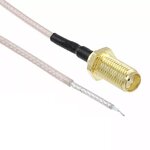pgib8
Member level 2
Hi, for tuning antennas, in the past the way I interfaced VNA to PCB is by soldering on an SMA connector as seen in the picture below. I assumed this is the best method because it allowed me to use a professional calibration kit for the cable that would connect to the soldered-on connector.
The down-side is that the calibration is slightly off from the actual measuring location due to the soldered-on connector.

I'm measuring around 915MHz.
Someone told me that it would be smarter to get a coax cable such as shown below, and solder it directly to the board. The downside is I can't use the calibration kit, so I would have to use a good old 50 Ohm resistor, and simple open/short to calibrate.

Which method would yield better results? If it's the second one, any special considerations for the 50 Ohm resistor (probably high accuracy)?
The down-side is that the calibration is slightly off from the actual measuring location due to the soldered-on connector.

I'm measuring around 915MHz.
Someone told me that it would be smarter to get a coax cable such as shown below, and solder it directly to the board. The downside is I can't use the calibration kit, so I would have to use a good old 50 Ohm resistor, and simple open/short to calibrate.

Which method would yield better results? If it's the second one, any special considerations for the 50 Ohm resistor (probably high accuracy)?